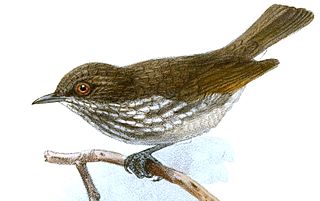
Zosterops is a genus of passerine birds containing the typical white-eyes in the white-eye family Zosteropidae. The genus has the largest number of species in the white-eye family. They occur in the Afrotropical, Indomalayan, and Australasian realms. Typical white-eyes have a length of between 8 and 15 cm. Their most characteristic feature is a conspicuous white feather ring around the eye, though some species lack it. The species in this group vary in the structural adaptations of the tongue. The Zosterops [griseotinctus] group is an example of a "great speciator" inhabiting a vast area and showing a remarkable morphological differentiation on islands, some of which maybe as close as 2 km (1.2 mi) apart.
Old World warblers are a large group of birds formerly grouped together in the bird family Sylviidae. They are not closely related to the New World warblers. The family held over 400 species in over 70 genera, and were the source of much taxonomic confusion. Two families were split out initially, the cisticolas into Cisticolidae and the kinglets into Regulidae. In the past ten years they have been the subject of much research and many species are now placed into other families, including the Acrocephalidae, Cettiidae, Phylloscopidae, and Megaluridae. In addition some species have been moved into existing families or have not yet had their placement fully resolved. A smaller number of warblers, together with some babblers formerly placed in the family Timaliidae and the parrotbills, are retained in a much smaller family Sylviidae.

The typical warblers are small birds belonging to the genus Sylvia in the "Old World warbler" family Sylviidae.

The white-eyes are a family, Zosteropidae, of small passerine birds native to tropical, subtropical and temperate Sub-Saharan Africa, southern and eastern Asia, and Australasia. White-eyes inhabit most tropical islands in the Indian Ocean, the western Pacific Ocean, and the Gulf of Guinea. Discounting some widespread members of the genus Zosterops, most species are endemic to single islands or archipelagos. The silvereye, Zosterops lateralis, naturally colonised New Zealand, where it is known as the "wax-eye" or tauhou ("stranger"), from 1855. The silvereye has also been introduced to the Society Islands in French Polynesia, while the Japanese white-eye has been introduced to Hawaii.

The Taiwan yuhina, also known as Formosan yuhina, is a small songbird endemic to the island of Taiwan.

Crossley's vanga, also known as Crossley's babbler-vanga, Crossley's babbler, Madagascar groundhunter, or Madagascar groundjumper, is a bird species in the family Vangidae.

Stachyris is a genus of passerine birds in the Old World babbler family Timaliidae.

The Palawan striped babbler is a species of bird in the family Zosteropidae. It is endemic to the Philippines, where it is only found in Palawan.
The Panay striped babbler is a species of bird in the family Zosteropidae and one of the most attractive birds in the country. It is endemic to the Philippines only being found on the island of Panay (Philippines). Its natural habitat is tropical moist montane forest. It is threatened by habitat loss.

The white-naped yuhina is a bird species in the white-eye family Zosteropidae.

The striated yuhina is a bird species in the white-eye family Zosteropidae.

The white-collared yuhina is a bird species in the white-eye family Zosteropidae.

The chestnut-crested yuhina is a species of bird in the white-eye family Zosteropidae. The species has been included in the genus Staphida, along with the Indochinese yuhina and the striated yuhina of mainland Asia, and all three have been considered a single species. The scientific name commemorates British colonial administrator and zoological collector Alfred Hart Everett.

The stripe-throated yuhina is a bird species in the white-eye family Zosteropidae.

The black-chinned yuhina is a bird species in the white-eye family Zosteropidae.

The rufous-vented yuhina is a bird species in the white-eye family Zosteropidae. It is found along the northern parts of the Indian subcontinent, primarily in the Eastern Himalayas, and ranges across Bhutan, India, Tibet, Myanmar, and Nepal. Its natural habitat is subtropical or tropical moist montane forests.

The white-bellied erpornis or simply erpornis is a species of bird. It is the only member of the genus Erpornis. This bird is found in Bangladesh, Bhutan, Brunei, Cambodia, China, India, Indonesia, Laos, Malaysia, Myanmar, Nepal, Singapore, Taiwan, Thailand, and Vietnam. Its natural habitat is subtropical or tropical moist montane forests.

Sterrhoptilus is a songbird genus recently separated from Stachyris. It used to be placed in the family Timaliidae. With other "Old World babblers" of the genus Yuhina, it was recently determined to be better placed in the family Zosteropidae.

Zosterornis is a genus of passerine birds in the white-eye family Zosteropidae. The five species in the genus are endemic to the Philippines.

The Visayan pygmy babbler is a bird species endemic to the Philippines. It belongs to the genus Dasycrotapha. It was placed in the family Timaliidae, but recently found to be better placed in the family Zosteropidae.


















